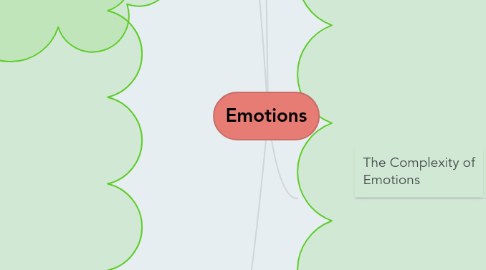
1. What is an Emotion?
1.1. Typical Cause of An Emotion
1.1.1. an emotion occurs when there has been a significant change in our personal situation
1.1.2. may be positive or negative change, or a change impacted someone close to us
1.1.3. this change disrupts our status quo, inducing an emotional response
1.1.4. from an evolutionary standpoint, change helps to stimulate our awareness
1.1.5. no emotion felt if the change is not perceived as significant. Levels of significance and determine emotional intensity
1.2. Typical Emotional Concern: A Comparative Personal Concern
1.2.1. comparing a significant change (what will be) to an individual's perceived baseline environment (what is), will invoke emotions.
1.2.2. comparison may be made to an ideal state, situations of others and to normative states
1.2.3. emotions may involve imagination, in that a change may or may not be real or as significant as it may be in reality
1.2.4. the more significant the change, the more intense the emotion
1.2.5. the availability of alternative situation when comparing a significant change (inducing an emotion) will determine intensity of an emotion
1.2.5.1. emotions are more intense when the alternative is an easy one to imagine. e.g a near miss or a near win
1.2.6. relationships with other people play an important role in the development of emotions
1.2.6.1. with social comparison one can compare one's current state to that of others
1.2.6.2. leads to the development of emotions, depending on whether or not the evaluation of this comparison is positive or negative
1.2.7. the development of an emotion is influenced by the groups in which an individual is a part of- either a social or reference group
1.2.7.1. a social group are the people we have close connections to, and may ignite emotions like love, compassion or happy-for
1.2.7.2. a reference group is formed of people we are comparing ourselves to, or who we identify with or who we want to be. Emotions associated with this group membership are envy, shame, hate and pride
1.2.7.3. group membership reflects a person's main attributes such as values, goals and well being, which influence emotions
1.3. Typical Emotional Object: A Human Being
1.3.1. Emotions are typically experienced by a person or about a person, and occasionally about a group of people
1.3.1.1. Emotions can be directed at inanimate objects or other living things like animals
1.4. Typical Characteristics
1.4.1. emotions are often a result of an unstable mental status due to the uncertainty of the future because of a significant change. This instability leads to intense emotions
1.4.2. emotions are intense due to the attention required as a result of a significant change- if the change was not significant, an emotion would not necessarily be generated as it did not illicit an intense response
1.4.3. emotions have a degree of partiality- they focus on a small target and are an expression of a personal perspective
1.4.4. emotions are typically short lived
1.4.4.1. once the change is initially responded to by an emotion, the instability will soon fade and a new norm will prevail, and emotions will calm
2. Basic Components of an Emotion
2.1. Intentionality and Feeling
2.1.1. Intentional Components
2.1.1.1. Cognitive
2.1.1.1.1. basic information about a situation that influences an emotion
2.1.1.1.2. can be distorted due to partiality and closeness (unable to see the whole picture) and intense feeling (overwhelming feelings lead to poor cognitive responses)
2.1.1.1.3. cognitive components of emotions are influenced by our environment, the emotional cause, and focus of concern
2.1.1.2. Evaluative
2.1.1.2.1. an emotion is based either on a positive or negative evaluation of a situation
2.1.1.2.2. emotions can have a mixture of both a positive and negative evaluation
2.1.1.2.3. deliberative evaluations results from rumination, are conscious, voluntary thoughts, may prepare the mind for schematic evaluations
2.1.1.2.4. schematic evaluations are spontaneous, automatic responses, requires the right circumstances to develop this primitive response, the majority of emotions are developed this way
2.1.1.3. 0
2.1.1.4. Motivational
2.1.1.4.1. the desire or readiness to alter or maintain status quo, prepares one to act if necessary, a practical concern
2.1.1.4.2. can be connected to behaviours, expressed in desires or wants
2.1.2. Feeling Component
2.1.2.1. how our awareness of our situation and environment is expressed
2.1.2.2. can be very noticeable and intense with emotional states, however they are unintentional
3. The content presented in this MindMap is a summary of the main themes from Chapters 1-3 of the book "The Subtlety of Emotions" by Aaron Ben-Ze'ev (2000).
4. The Complexity of Emotions
4.1. Reasons why emotions are complex
4.1.1. individual, subjective, personal, not always repeatable in different situations
4.1.2. have many forms
4.1.3. have public and private features
4.1.4. often are not experienced as a single emotion but as a cluster
4.2. Explaining emotions with conceptual tools
4.2.1. The Prototype Analysis
4.2.1.1. using a "typical case" to describe an important characteristics of an emotion, usually context-free
4.2.1.2. can be difficult to define a typical case, when extreme and common cases also exist
4.2.1.3. entails both a broad outline of a typical case as well as detailed analysis of an emotion
4.2.2. Levels of Description
4.2.2.1. describing an emotion in terms of physiological, psychological, sociological, biological or philosophical
4.2.3. Systematic Classifications
4.2.3.1. need to be systematic when describing emotions
4.2.3.2. will reduce complexity and heterogeneity

